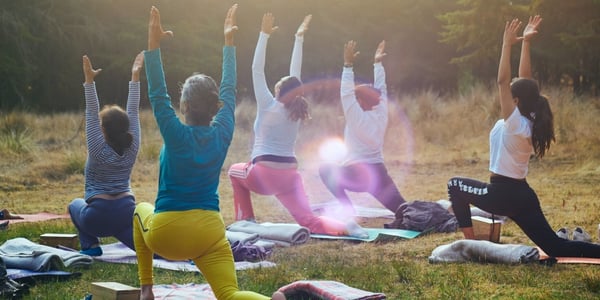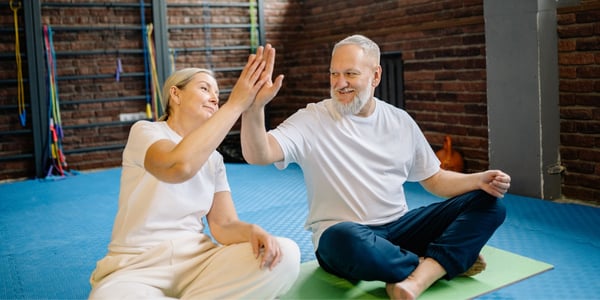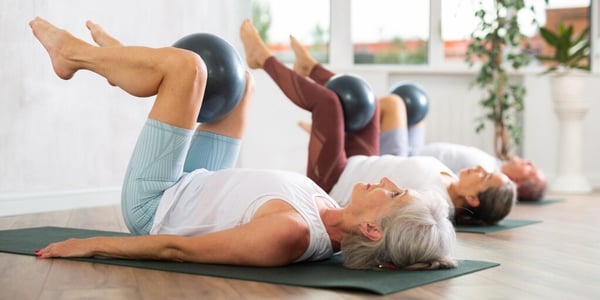Swimming is often considered one of the best exercise options. Typically, children start swimming...
Tips for Getting Back into Exercise After 55
It's never too late to start or restart your fitness journey. As we reach age 50 and beyond, exercise becomes increasingly essential for maintaining overall health, vitality, and independence. Regular physical activity can enhance strength and flexibility, improve cardiovascular health, and boost mood and cognitive function. However, getting back into exercise after a period of inactivity or during a transitional phase requires a thoughtful approach.
Regardless of your past exercise experience, these tips will help you to take the first steps towards a healthier, active lifestyle. Each recommendation is designed to ensure a safe and enjoyable exercise experience.
16 Easy Tips to Get Back into Working Out
1. Consult With Your Healthcare Provider
Before embarking on any new exercise routine, it's crucial to consult your healthcare provider. This step cannot be emphasized enough, as it ensures that you have professional guidance tailored to your unique health needs. Schedule an appointment with your doctor or a qualified healthcare professional who can assess your current health status, review any underlying conditions you may have, and provide personalized recommendations.
Consulting with your healthcare provider is particularly important if you have any chronic illnesses or injuries or if it has been a while since you engaged in regular physical activity. In addition, your healthcare provider can help identify any specific considerations or modifications you may need to make to your exercise routine to ensure safety and effectiveness.
2. Start Slowly
It's important to start slowly. This approach allows your body to adjust and adapt to the physical demands, reducing the risk of injury and excessive fatigue. Begin with low-impact activities that are easy on the joints, such as walking, swimming, or biking. Aim for 10-15 minutes of exercise daily and gradually increase the duration and intensity of your workouts as you become more comfortable and confident. This gradual progression allows your muscles, tendons, and cardiovascular system to strengthen and adapt over time. Remember, there's no rush - the focus is on consistency and sustainability. If you feel pain or discomfort, adjust your routine accordingly or seek guidance from a qualified professional.
3. Find Activities You Enjoy
Participating in activities that you find enjoyable increases the likelihood that you'll stick with them in the long run. The options are vast and can be tailored to your preferences and interests. Consider dancing, hiking, gardening, tennis, golf, or even joining a local sports group. Experiment with different types of exercise until you find what resonates with you. Remember, exercise doesn't have to be limited to traditional gym workouts - it can be any way to stay active that brings you joy. Click here to learn about more ways to make working out more fun!
4. Listen to Your Body
As you get back into exercise, developing a strong connection with your body and paying close attention to its signals is crucial. Each person's fitness journey is unique, and it's essential to understand and respect your body's limitations and needs. Take note of how your body responds to different exercises and intensities. Notice any sensations of discomfort, pain, or excessive fatigue. These signals are your body's way of communicating with you. If you experience discomfort, adjust your routine accordingly, and don't hesitate to seek guidance from a qualified professional.
Remember, there's a difference between pushing yourself outside your comfort zone and pushing yourself to the point of harm. Developing a mindful and intuitive approach to exercise will help you understand when to safely push harder and when to take a step back.
5. Make it a Social Experience
Making exercise a social experience can enhance your motivation and enjoyment. Consider involving family members, friends, or like-minded individuals in your exercise routine. Join fitness classes or group activities that align with your interests. Exercising with others provides a sense of accountability, support, and camaraderie. It can make the experience more enjoyable and provide an opportunity for social connection.
Whether it's joining a walking group, participating in group fitness classes, or even working out with a friend at the gym, the social aspect of exercise adds an extra layer of fun and motivation. It allows you to share your goals, experiences, and challenges with others who understand and support your journey. Additionally, it opens doors to new friendships and fosters a sense of community. Click here to read more about the benefits of working out with others!
6. Warm Up and Cool Down Properly
Before diving into your exercise session, it's essential to prioritize a proper warm-up and cool-down routine. Warm-up exercises prepare your body for physical activity. Engage in dynamic stretches, light aerobic movements, or even a short walk to warm up your muscles and loosen your joints. These warm-up exercises help improve flexibility, enhance range of motion, and reduce injury risk. Similarly, cooling down after exercise is equally important. Allocate time for gentle stretches or low-intensity movements to safely bring your heart rate back to its resting state. Cooling down helps your body recover and helps prevent muscle soreness and stiffness.
7. Stay Hydrated
Proper hydration is vital for individuals of all ages, particularly during exercise. As you engage in physical activity, your body loses water through sweat, making it crucial to replenish those fluids. Adequate hydration supports optimal performance, helps regulate body temperature, and ensures the proper functioning of various bodily systems. Aim to drink water before, during, and after your workout to stay hydrated. Keep a water bottle handy during exercise sessions and take regular sips to prevent dehydration. Pay attention to your body's thirst cues and practice hydrating throughout the day, not just during exercise. Additionally, consider incorporating hydrating foods, such as fruits and vegetables, into your diet.
8. Embrace Variety
Adding variety to your exercise routine offers numerous benefits, especially as you get back into exercise at 50+. Incorporating different types of exercises not only keeps things interesting and enjoyable but also targets various muscle groups, enhances overall fitness, and reduces the risk of overuse injuries. Explore a range of activities such as aerobic exercises, strength training, flexibility exercises, and even outdoor activities like hiking or gardening. Try new fitness classes, experiment with different workout equipment, or engage in recreational activities that challenge your body in different ways. Variety prevents boredom and stimulates your mind and body, helping you stay motivated and engaged in your fitness journey.
9. Prioritize Rest and Recovery
While it's essential to maintain consistency in your exercise routine, it's equally crucial to prioritize rest and recovery days. Your body requires time to repair and rebuild after physical activity, ensuring optimal performance and minimizing the risk of overtraining or burnout. Incorporating rest days into your schedule allows your muscles, joints, and connective tissues to recover and adapt to the stress of exercise. Listen to your body's cues for rest and pay attention to any signs of fatigue, soreness, or decreased performance. Additionally, prioritize quality sleep as part of your recovery routine. Aim for 7-9 hours of sound sleep each night to support muscle repair, hormone regulation, and overall well-being.
10. Set SMART Goals
When embarking on your exercise journey, it's crucial to set SMART goals that align with your current fitness level and lifestyle. Take the time to reflect on what you want to accomplish and break it down into manageable milestones. Consider your overall health, physical limitations, and the time you can realistically dedicate to exercise. Start with modest objectives that you can build upon over time. For example, aim to walk for 20 minutes three times a week or complete a specific number of repetitions in a strength training exercise. As you achieve these smaller goals, you'll gain confidence and motivation to push yourself further. Remember that progress is personal, and every step forward, no matter how small, is worth celebrating.
11. Track Your Progress
Tracking your progress is a powerful tool to keep you motivated, accountable, and aware of the strides you're making in your exercise routine. Consider using a fitness journal, a dedicated app, or a fitness tracker to record your workouts, duration, intensity, and any improvements you notice. Regularly revisit your journal or app to review your progress. Celebrate both minor and significant achievements, such as increased endurance, improved strength, or reaching a new milestone. Tracking your progress allows you to visualize your dedication and hard work, providing a source of motivation during challenging times. It also helps you identify patterns, adjust your routine if needed, and make informed decisions about your fitness goals.
12. Seek Support
Embarking on an exercise journey is often more successful and enjoyable when you have a supportive network. Seek support from friends, family, or like-minded individuals who share similar goals or interests. Share your fitness journey with them and ask for their encouragement and accountability. Consider joining local community groups, fitness classes, or online communities focused on exercise for individuals 50+. These communities can provide a sense of camaraderie, valuable advice, and motivation to stay on track.
Additionally, consider working with a personal trainer who specializes in working with older adults. They can provide expert guidance, tailor exercises to your specific needs, and ensure proper form and safety. Having a support system in place increases your likelihood of sticking to your new exercise routine and makes the journey more enjoyable.
13. Embrace a Positive Mindset
When getting back into exercise, it's crucial to cultivate a positive mindset that supports your journey. Approach exercise with a mindset of self-care, self-compassion, and gratitude for your body's abilities. Focus on the positive aspects of incorporating physical activity into your life, such as improved energy levels, enhanced mood, and overall well-being. Embrace the idea that exercise is not a punishment or a chore but a gift you give yourself. Practice positive self-talk and challenge any negative thoughts or self-limiting beliefs that may arise. Replace them with affirmations that encourage and motivate you. Recognize that progress is not always linear and that setbacks or plateaus are a natural part of the process. Embrace them as opportunities for growth and learning.
14. Schedule Exercise into Your Routine
It's important to schedule it into your daily or weekly routine to make exercise a regular part of your life. Treat it as an important appointment with yourself and prioritize it accordingly. Pick a time of day when you are the most energized and least likely to be interrupted. Block off dedicated time for exercise in your calendar and view it as non-negotiable. Communicate your commitment to exercise with those around you so they understand its importance to you and can support your efforts. By scheduling exercise, you create a sense of structure and accountability, making it more likely that you'll follow through. It becomes a habit. Over time, the consistency will reinforce your commitment to exercise and become second nature.
15. Use Technology
Take advantage of the great apps and resources available to support your exercise journey. Explore fitness apps or online workout videos specifically designed for older adults. These resources often provide guided workouts, tracking features, and modifications for different fitness levels. They can be a valuable source of inspiration, instruction, and motivation. Use fitness trackers or smartwatches to monitor your heart rate, steps, or calorie expenditure, providing real-time feedback on your progress. These devices can help you set goals, track your activity, and provide a sense of accomplishment as you meet your targets. Additionally, you can find podcasts or audiobooks to listen to while walking or exercising, making the experience more enjoyable and engaging.
16. Celebrate Non-Scale Victories
While weight loss or changes in body composition may be goals for some individuals, it's essential to recognize and celebrate other positive outcomes of exercise beyond the scale. Pay attention to changes in your energy levels, mood, sleep quality, flexibility, strength, or overall endurance. Notice how exercise positively impacts your daily life, such as making everyday tasks easier or allowing you to engage in activities you love. Celebrate the ability to walk a longer distance, perform exercises with better form, or experience increased stamina during physical activities. Take note of how exercise positively influences your mental and emotional well-being, such as reduced stress or increased self-confidence. By acknowledging and celebrating these non-scale victories, you shift your focus from external metrics to the internal, holistic benefits of exercise. Celebrating your accomplishments reinforces the notion that exercise is about overall health, vitality, and improved quality of life. So, take the time to acknowledge and celebrate each small victory along the way.
Getting back into exercise at 50+ is a personal and transformative journey. It requires patience, self-compassion, and a willingness to adapt.
Remember, the goal is not perfection but progress and the long-term integration of exercise into your lifestyle. Each step you take, regardless of how small, each step you take is a step toward improved health, vitality, and well-being.









